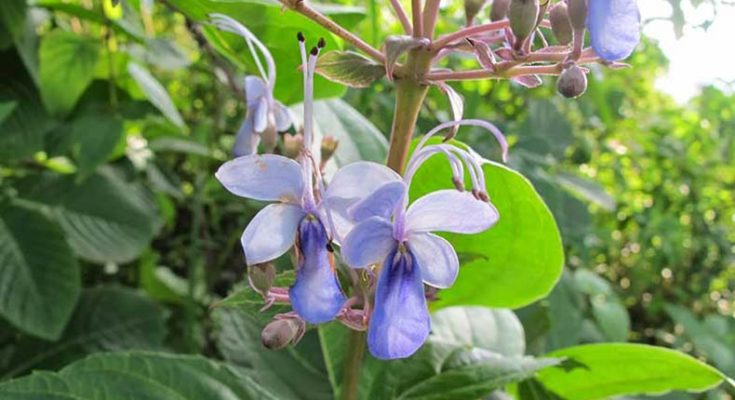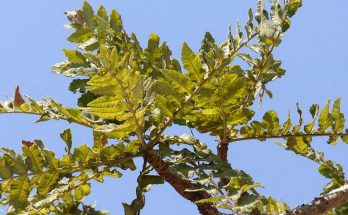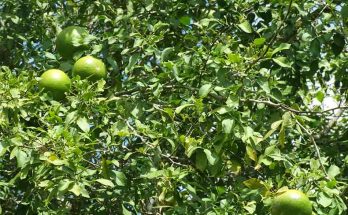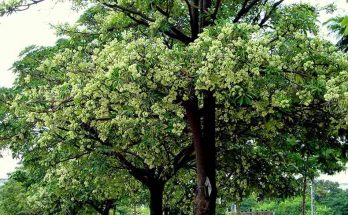Manifold uses of Beetle Killer. Image Courtesy – http://onalongleash.blogspot.in
Ayurveda has tremendous potential herbs in its list, many of them we know and many of them we do not know. Many herbs are there we have hardly listened to or used in our lives. But, scientific researchers have been continuously researching various herbs and observing the results of their examinations and used to write Pharmacological reviews on them. We would like to analyze one of the herbs which give immense benefits to a human being.
The name of the herb in English is ‘Beetle Killer’ or ‘Blue Glory’, it is called ‘Bharangi’ in Hindi, ‘Brahmanayashtika’ or ‘Padma’ in Sanskrit, it is called ‘Cheruthekku’ in Malayalam, etc. The scientific name of the herb is ‘Clerodendrum Serratum’, and it belongs to the ‘Verbenaceae’ family.
‘Beetle Killer’ is a type of bush accomplishing the stature of 3-8 ft, with obtusely quadrangular stems and very little spread. Its youthful parts generally look glabrous. Leaves of ‘Beetle Killer’ are typically three at the hub, inverse, coarsely and pointedly serrate, glabrous, base intense, hefty petioles. Various gaudy blooms with a couple of intense bracts at every spreading and blossom in the fork.
Read: Periwinkle – the great herb to combat Diabetes and Cancer
There are formations of Pale blue corolla, glabrous outside, cylindric, bushy inside the tube at the insertion of the stamens. The 2 upper and 2 parallel flaps are elliptic, level, spreading, and the lower projection lip-like, sunken. This herb is the native plant of East India and Malaysia. It has been distributed in the forests of Srilanka also. Flowers in this plant can be observed between August and September.
This plant usually grows in warm tropical temperatures and up to 1500m higher altitude in the Indian subcontinent. ‘Beetle Killer’ usually becomes 2 to 8 feet long. Its roots, stems, the cover of stems, leaves, etc. are used as medicine.
Therapeutic Use: Root is sharp, severe, harsh, dry, warming, mitigating, digestive, carminative, depurative, expectorant, antispasmodic, stimulant, appetizer, and anthelmintic. It is utilized clinically as a part of the treatment of bronchitis, asthma, fevers, blood sickness, tumours, irritations, smouldering sensation, epilepsy, intestinal sickness, ulcer and wounds. Leaves are utilized as a part of fever and hiccough. Its bubbled leaves are utilized as a part of cephalgia and ophthalmia where as its bubbled seeds in margarine milk is utilized as aperients, in dropsy and in catarrhal fondness of lungs. Root bark contains mostly sapogenins, while leaves contain flavonoids and phenolic acids. This herb is used due to its high antibacterial properties.
A number of minerals like Na, Mg, Al, Ca, etc., ‘seponins’, ‘terpenoids’, ‘D-mannitol’ are the ‘phyconstituents’ which are found in ‘Beetle Killer’. Researchers are studying ‘pharmacognostic’, ‘physicochemical’, ‘hepatoprotective’, ‘anti-oxidant’, ‘anti-inflammatory’, ‘analgesic’, ‘antiasthmatic’, and more other capabilities of the plant. A clinical trial has also been conducted on patients of ‘Bronchial Asthma’, and there are further scopes for clinical activity.
Read: Healing power of Bougainvillea
Steroids are terpenes based on the ‘cyclopentane per hydroxy phenanthrene’ ring. Mainly, ‘γ-sitosterol’, ‘β-sitosterol’, ‘cholestanol’, ‘clerosterol’, ‘campesterol’ and ‘24-ethyl cholesterol’ were reported to be separated from the significant plant.
The root of this plant is used for Jaundice in rural areas of India as people believe that a garland made by tiny roots of this plant can have the power to cure the disease. People in rural areas use this plant’s roots for astrological remedies. In their opinion, ‘Beetle Killer’ or ‘Bharangi’ supports the planet ‘Jupiter’ according to astrology. So, they frequently use the roots of this plant to achieve the positive qualities of Jupiter as per astrological prescription.
Caution: Though this herb has numerous healing properties, its use should be restricted in some cases. People must avoid this herb during pregnancy and Breast Feeding.
Reference: Journal of Applied Pharmaceutical Science 02 (02); 2012: 11-15





